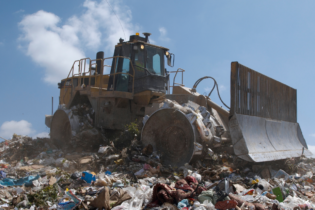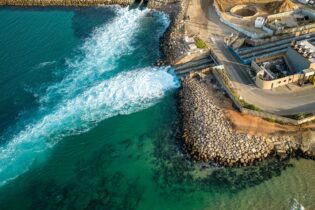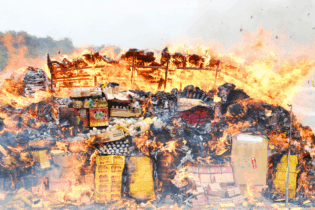The Ekurhuleni Metropolitan Municipality (EMM) is engaged in a Clean Development Mechanism (CDM) Project based on landfill gas recovery and flaring at four of its landfills. The latest phase – Phase 3 – involved the expansion of the active LFG extraction systems at two of the sites, namely Weltevreden and Rooikraal, finds Chantelle van Schalkwyk.
“The extraction and utilisation of landfill gas reduces harmful greenhouse gas (GHG) emissions and prevents explosion hazards at the landfill sites from the accumulation of methane gas,” explains EMM spokesperson, Sam Modiba. The four sites at which the CDM project is being implemented are Weltevreden, Rooikraal, Simmer & Jack and Rietfontein. Setting the scene The assessment of the potential for landfill gas (LG) extraction and utilisation at EMM sites began in 2005 with a feasibility study and trial of landfill gas extraction and flaring. The study found, according to Modiba, that gas extraction and power generation were feasible and financially viable under the CDM of the Kyoto Protocol, “which would allow for revenue to be obtained from the sale of emission reductions”. CDM registration was finalised in February 2011, with the CDM project intended to be implemented in two phases. In Phase 1, Modiba explains that the LFG was to be extracted and flared and in Phase 2 the intention was to use the LFG for power generation and to export electricity to the grid. In this sense, Phase 2 is to have been launched in July this year. Since project inception, a total of 340 080 tCO²eq have been reduced to the atmosphere. EMM is currently seeking a buyer for the carbon credits, with a number of local and international entities reportedly having shown interest in acquiring the credits. “The Waste Management Services Department adopted a plan to increase the gas extraction at the landfill sites, thereby enhancing the CERs, as well as improving the air quality and reducing odour at the landfill sites,” explains Modiba, adding that the new gas well installations will also occur in a phased approach, with phases 1 to 4 running consecutively from May 2011 until June 2014. Phase 3 is the most recent phase of the project and involved the expansion of the active LFG extraction systems at two of the sites, namely Weltevreden and Rooikraal. Beneficial bonus As an added benefit, due to the fact that all EMM landfills are situated in and around residential areas, the implementation of the CDM project has also resulted in a number of environmental and social benefits to the surrounding communities, adds Modiba. “The local air quality has improved as a result of the project due to the extraction and combustion of landfill gas. The potential for migration of landfill gas has also been reduced thus significantly reducing the risk of explosion, toxicity and asphyxiation due to LFG accumulation.” In addition, according to Modiba, this has been a pioneering technology in South Africa, which has resulted in the birth of a new industry locally. “The project has resulted in the importation of new technology to the country and the transfer of skills to everyone involved – from the operations and maintenance personnel to the project design engineers.” He adds that at least three companies have been involved in this project on a permanent basis and another three on a non-permanent basis for the gas well installations. Two of those companies were Fountain Civil Engineers (FCE,) which was appointed as the civil contractor to undertake the construction of the Phase 3 works, and Jones & Wagener, which, as the consulting engineer, has been involved with the project from the beginning and have designed and supervised all construction to date. On-site intricacies The project was nearing completion when ReSource spoke to the team early in July and construction was expected to be completed mid-July, which is earlier than the originally projected end of July 2013, according to Jones & Wagener’s Shaun Devine, explaining that his company has extensive experience in all classes of landfill design and specialises in landfill gas extraction systems, being involved in the design of gas systems on both municipal and private landfills. The greatest challenge on-site, according to Devine, has been coordinating the filling of the site – which is part of the daily operations – with the construction of the gas welling going on at the same time. “These two processes need to work hand-in-hand for timely and economical installation of the wells and harmonious landfilling practice,” says Devine.The works carried out by FCE include installation of the horizontal wells into the waste body, installation of manifold boxes, installation of condensate knockouts, installation of the collection pipe network to channel the gas from the wells to the existing flare unit and repairs of the existing on-site infrastructure. FCE’s Justin Butt explains:“We were responsible for all trenching, earthworks and installation of the gas extraction and conveyance pipe network.”
Butt adds that FCE was uniquely suited to the project because it has carried out numerous landfill gas extraction projects in the past for Ekurhuleni and other clients. “Since 2007, FCE has completed many landfill gas extraction projects throughout South Africa. We have a well-established team of landfill gas staff who are well aware of the challenges of dealing with highly flammable, wet gas,” continues Butt. He adds that FCE completed Phase 2 of the landfill gas contract at both Rooikraal and Weltevreden and were thus well acquainted with the existing site layout and pipe network for tying in the new gas wells. “FCE has established its own trained, certified HDPE pipe welding team that is able to provide accurate computerised weld data records,” says Butt. However, this does not mean that the project was all smooth sailing. The installation of the pipeline was still a necessitated specialised approach, says Butt. “Gradients and falls on the pipelines are extremely critical. If sufficient grades are not maintained at all times you run the risk of condensate build up in the pipes, which can lead to a blockage in the system.” He adds that one also needs to try factor in the fact that the landfill will settle over time, “thus changing the gradients on the pipelines that have been laid”. Careful consideration For Butt and the FCE team, one of the greatest challenges is on-site odour control. “Odour control when excavating into waste is always a problem. Digging into weeks-old waste is not the most pleasant smelling operation and needs careful consideration for the surrounding communities,” says Butt, adding that in order to overcome this challenge they make use of perfumed disinfectant that is continuously sprayed onto the excavated waste, with no excavated waste allowed to sit overnight. “All waste must be covered or taken to the working landfill face before the end of each working day,” says Butt. Devine adds that a landfill site is a hazardous place and has been responsible for some deaths and serious injuries, therefore beside conforming to the OHS and Construction regulations, the contractor also needs to provide a comprehensive health and safety plan for working on a landfill – especially catering for protecting workers from exposure to landfill gas. Butt adds that with FCE’s experience in landfills and landfill gas, the team has learnt to cope with the challenges of working on an active landfill site. “All appropriate PPE must be worn at all times when working in waste; gas masks are readily at hand should any person be required to enter into an area that may potentially be high in gas. We also have a gas monitoring device to detect any harmful or explosive gases and emergency showers are available to wash people down as quickly as possible should they be contaminated. “The most important rule to be followed at all times on-site, and which is driven home daily at the toolbox talks is that there should be no smoking. Designated smoking stations are marked out at the site camp where smoking is allowed,” says Butt. Continuous communication is therefore essential. “Open channels of communication and regular updates as to the work progress on-site keep all involved parties informed as to when and where things are happening and their respective roles to play,” says Devine. The next step According to Butt, the highlight of the project has been that it has cemented FCE’s place as the leading landfill gas contractor in South Africa. “The highlight of this project for us is the reduction of greenhouse gases and the utilisation of an unavoidable but valuable renewable resource,” says Devine, adding that Jones & Wagener will be responsible for the future construction phases until the middle of 2016. The next construction phase is expected to start in November this year.






